The Effect of Al2O3 Addition on the Thermal Diffusivity of Heat Activated Acrylic Resin
Jyothi Atla1, Prakash Manne2, A. Gopinadh3, Anche Sampath4, Suresh Babu Muvva5, Krishna Kishore6, Chiramana Sandeep7, Harika Chittamsetty8
1 Assistant Professor, Department of Prosthodontics, Sibar Institute of Dental Sciences, Guntur, A.P., India.
2 Professor, Department of Prosthodontics, Sibar Institute of Dental Sciences, Guntur, A.P., India.
3 Professor & HOD, Department of Prosthodontics, Sibar Institute of Dental Sciences, Guntur, A.P., India.
4 Reader, Department of Prosthodontics, Sibar Institute of Dental Sciences, Guntur, A.P., India.
5 Assistant Professor, Department of Prosthodontics, Sibar Institute of Dental Sciences, Guntur, A.P., India.
6 Professor, Department of Prosthodontics, Sibar Institute of Dental Sciences, Guntur, A.P., India.
7 Professor, Department of Prosthodontics, Sibar Institute of Dental Sciences, Guntur, A.P., India.
8 Assistant Professor, Department of Oral and Maxillofacial Pathology, Sri Sai College of Dental Surgery, Vikarabad, A.P., India.
NAME, ADDRES, E-MAIL ID OF THE CORESPONDING AUTHOR: Dr. Jyothi Atla, Assistant Professor, Department of Prosthodontics, Sibar institute of Dental Sciences, Takellapadu, Guntur-9, A.P., India.
Phone: 9492776417,
E-mail: drjyothimds@gmail.com
Aim: This study aimed at investigating the effect of adding 5% to 20% by weight aluminium oxide powder (Al2O3) on thermal diffusivity of heat–polymerized acrylic resin.
Material and Methods: Twenty five cylindrical test specimens with an embedded thermocouple were used to determine thermal diffusivity over a physiologic temperature range (0 to 70°C). The specimens were divided into five groups (5 specimens/group) which were coded A to E. Group A was the control group (unmodified acrylic resin specimens). The specimens of the remaining four groups were reinforced with 5%, 10%, 15%, and 20% Al2O3 by weight. Results were analysed by using one–way analysis of variance (ANOVA).
Results: Test specimens which belonged to Group E showed the highest mean thermal diffusivity value of 10.7mm2/sec, followed by D (9.09mm2/sec), C (8.49mm2/sec), B(8.28mm2/sec) and A(6.48mm2/sec) groups respectively. Thermal diffusivities of the reinforced acrylic resins were found to be significantly higher than that of the unmodified acrylic resin. Thermal diffusivity was found to increase in proportion to the weight percentage of alumina filler.
Conclusion: Al2O3 fillers have potential to provide increased thermal diffusivity. Increasing the heat transfer characteristics of the acrylic resin base material could lead to more patient satisfaction.
Heat activated acrylic resin, Aluminium oxide, Thermal diffusivity, Thermo couple
Introduction
Despite of the fact that we have landed in a very modern era of dentistry, the continuous search for an ideal denture base material has remained a challenge yet [1]. Poly methyl methacrylate (PMMA) denture base material which has been introduced in 1937 by Dr. Walter Wright is considered to be the most popular denture base material till date [2]. However, it has its own disadvantages, among which thermal diffusivity is of prime concern.
Thermal diffusivity is a material property which is related to thermal conductivity, which measures the rate at which a body with a non uniform temperature reaches equilibrium [3,4]. Usually, the PMMAs have low thermal diffusivity values as compared to metals. In an attempt to improve the thermal diffusivity, a more thermally conducting phase within the insulating acrylic resin matrix was introduced. As per the studies of Kawahara et al., aluminium proved to be the biocompatible material [5]. Aluminium oxide, which is commonly referred to as alumina, has high hardness, excellent dielectric properties, refractoriness, and good thermal properties, Which makes it the material of choice for a wide range of applications. Hence, many authors have proposed the addition of aluminium oxide to heat cure acrylic resin, in order to improvise the thermal diffusivity.
Aluminium oxide addition not only gives the advantages of increased strength and improved thermal properties, high hardness and refractoriness, but also it reduces the polymerisation shrinkage, decreases the warpage, makes the material radio opaque and inhibits the growth of bacteria over the denture surface [6, 7].
The present in vitro study was undertaken to evaluate the thermal diffusivity of heat cure acrylic resin samples which were reinforced with aluminium in increasing weight proportions.
Material and Methods
Solid aluminium cylinders of 10mm × 10mm [Table/Fig-1] were manufactured and they were invested to create mold spaces to fabricate acrylic specimens. Resin powder was then proportioned along with fillers (5, 10, 15 and 20 weight percent alumina) which were mixed with monomer and this was packed at a dough stage and placed under a hydraulic press. Flasks were briefly opened for the insertion of thermocouple leads [Table/Fig-2] into the two halves of the cylindrical specimens, after which all the specimens were subjected to acrylisation in a temperature controlled acrylizer (Unident) [Table/Fig-3]. After cooling to room temperature, the specimens were removed from the moulds. A total of 25 samples were prepared and they were categorised into 5 groups, namely, A, B C, D and E. Each group consisted of 5 samples. Group ‘A’ was the control group (unmodified acrylic resin specimens). The remaining four Groups B, C, D and E consisted of specimens which were reinforced with aluminium oxide (Al2O3) powder at the concentrations of 5%, 10%, 15%, and 20% by weight respectively.
Cylindrical aluminium dies for preparing the specimens to test thermal diffusivity
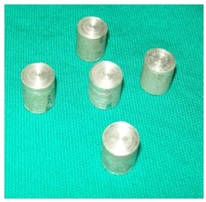
Insertion of thermo couple leads in to the cylindrical specimens
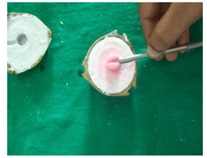
Acryliser for acrylising the specimes
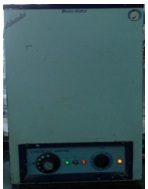
Thermal diffusivity was measured by using a technique which was developed by Watts and Smith [8]. This techniques allows an accurate and a rapid determination of thermal diffusivity by using specimens of cylindrical geometry that contain an embedded thermocouple for temperature measurement within the specimen. Specimen thermocouple leads were attached to a personal computer recorder for measurement of transient temperature changes at the centre of the cylinder. All specimens were conditioned at room temperature in distilled water for 24 hours and then they were equilibrated in an ice bath for 30 minutes before they were tested [Table/Fig-4], as the minimum temperature of the oral cavity can be subjected to 0°C during the consumption of cold foods. The instrumented specimens were then immersed in a thermostated bath at 70°C [Table/Fig-5] and the temperature at the centre of each specimen was recorded for every two seconds, until 10 minutes. The resolution of all temperature measurements was 0.1°C.The temperature which was used in this study (0 to70°C) was chosen to correspond to the temperatures of food and drinks that were likely to be ingested in a typical meal [9]. The results were analysed by using One-way ANOVA which was used to determine whether significant differences existed between the means of the experimental groups.
Specimens being equilibriated in an ice bath
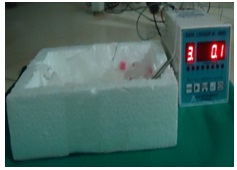
Instrumented specimens being subjected to Thermostated bath
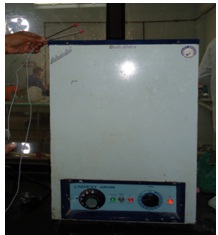
Results
The mean and standard deviation values of the thermal diffusivity (mm2/sec) of the groups ( A, B, C, D and E ) were evaluated [Table/Fig-6]. One–way ANOVA analysis showed an f–value of 8.753234. Since the p value was <0.05, it was found that there was a significant difference between the mean values of tested groups [Table/Fig- 7].
Represents the mean and standard deviation values of the thermal diffusivity (mm2/sec) of A, B, C, D, E groups
| Group | Mean | Sd |
|---|
| A (Control) | 6.48 | 2.96 |
| B (5%) | 8.28 | 2.2 |
| C (10%) | 8.49 | 2.96 |
| D (15%) | 9.09 | 3.95 |
| E (20%) | 10.7 | 3.68 |
Represents the ANOVA One–Way Test for thermal diffusivity,
| Source of Variation | SS | df | MS | F | P-value |
|---|
| Between Groups | 917.7479 | 4 | 229.437 | 8.753234 | <0.05 |
| Within Groups | 39186.46 | 1495 | 26.21168 | | |
| Total | 40104.21 | 1499 | | | |
SS– Sum of squares,
DF– Degree of freedom
Ms– Mean sum of squares
F– Variance ratio
Discussion
Acrylic resin is most commonly employed in the construction of dentures. Despite its popularity, it has often failed in resulting optimal thermal properties like thermal diffusivity. This is reflected in the frequent problem of lack of perception of temperature of food and beverages. Relatively few attempts of adding metallic powders and thermally conducting ceramics such as sapphire have been made, in order to develop acrylic resins with enhanced heat transfer characteristics. In one of the studies, Messermith P B reinforced PMMA with 9.35% and 15% by using volume sapphire whiskers (Al2O3). Thermal diffusivities of sapphire containing composites were found to be significantly higher than that of the unmodified acrylic resin. Thermal diffusivity was found to increase in proportion to the volume percentage of sapphire filler [10]. The current study was conducted to evaluate the thermal diffusivity of conventional heat cure acrylic resin, after addition of Al2O3 in varying weight proportions. Al2O3 was added at 5,10,15 and 20 Weight percentages to heat cure acrylic. The thermal diffusivity was evaluated by using a technique which was developed by Watts and Smith. Thermal diffusivity showed an increase in the values which was in proportion to the added filler aluminium oxide.
Conclusion
Within the limitations of this study, the following conclusions can be drawn. Incorporating Al2O3 powder from 5 to 20% by weight into conventional heat polymerized denture base resin, resulted in an increased thermal diffusivity, which ensured a better perception of temperature changes and which ultimately led to an enhanced patient satisfaction.
SS– Sum of squares,DF– Degree of freedomMs– Mean sum of squares F– Variance ratio
[1]. Yadav Naveen S, Hend Elkawash, Flexural strength of denture base resin reinforced with aluminium oxide and processed by different processing techniquesJ of Advanced Dental Research 2011 2:119-21. [Google Scholar]
[2]. Jacob John, Shivaputrappa A G, Ila S, Flexural strength of heat polymerised poly methyl methacrylate denture resin reinforced with glass, aramid or nylon fibersJ Prosthet Dent 2001 86:424-27. [Google Scholar]
[3]. Craig Robert G, O’Brien William, Powers John M, Dental MaterialsProperties and Manipulation 1992 5th editionMosby publications [Google Scholar]
[4]. Anusavice KJ, Phillip’s, science of dental materials 2003 11th editionW.B. Saunders Company [Google Scholar]
[5]. Kahawara H, Yamagami A, Nakamura M, Biological testing of dental materials by means of tissue cultureInt Dent J 1968 18:443-67. [Google Scholar]
[6]. Sehajpal SB, Sood VK, Effect of metal fillers on some physical properties of acrylic resinJ Prosthet Dent 1989 61:746-75. [Google Scholar]
[7]. Grant AA, Greene EH, Whisker reinforcement of Polymethyl Methacrylate denture base resinsAust Dent J 1967 12:29-33. [Google Scholar]
[8]. Kim SH, Watts DC, Effect of reinforcement with woven E-glass fibres on the impact strength of complete dentures fabricated with high-impact acrylic resinJ Prosthet Dent 2004 91:274-80. [Google Scholar]
[9]. Michailesco PM, An invivo recording of variations in oral temperature during meals: A pilot studyJ Prosthet Dent 1995 73:214-18. [Google Scholar]
[10]. Messersmith PB, Obrez A, New acrylic resin composite with improved thermal diffusivityJ Prosthet Dent 1998 79:278-84. [Google Scholar]